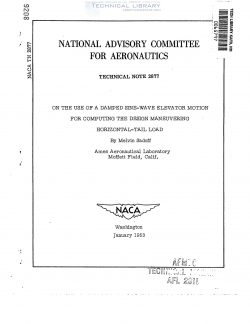naca-tn-2877
- Version
- 140 Downloads
- 874.39 KB File Size
- 1 File Count
- January 17, 2017 Create Date
- January 17, 2017 Last Updated
National Advisory Committee for Aeronautics, Technical Notes - On the Use of a Damped Sine Wave Elevator Motion for Computing the Design Maneuvering Horizontal Tail Load

A damped sine—wave elevator motion was used as a basis for computing
the design maneuvering load on the horizontal tail. Also investigated
was the effect of control frequency on the tail load. ’
The results indicated that the maneuvering tail-load variation
computed by operational methods with the assumed damped sine-wave elevator
motion agreed closely with the loads computed by a method currently
specified for use in the U.S. Air Force structural loading requirements.
This close agreement, coupled with the relative simplicity of the method
using the damped sineawave elevator motion, should encourage its use as
an alternative procedure for computing the design maneuvering horizontal-
tail load.
The maximum tail-load increments for a given design normal acceleration
factor were obtained at the highest control frequency investigated indicat-
ing that a very high control frequency should be selected in computing the
design maneuvering horizontal-tail load. For the practical case, however,
the design control frequency may be limited by either the availability of
control or by the physical or mechanical limitations with regard to
control rate of the pilot or boost system used.
Considerable attention has been given to the problem of devising
a simple and rational method for computing the maneuvering horizontal-
tail loads associated with abrupt elevator motions. In reference 1, a
graphical integration procedure is used to determine the tail-load
variation following any arbitrary elevator motion. In reference 2, a
numerical integration method is used for computing the design maneuvering
tail loads associated with an elevator motion represented by several
straight-line segments simulating a pull—up push-down maneuver. The
latter method has been adopted in the U.S. Air Force structural loading
specifications.
Although the methods described in references 1 and 2 were a
considerable improvement over methods previously available, it is believed
further simplification of the computational procedure may be realized by
considering a damped sine~wave elevator motion in computing the design
maneuvering tail load. The damped sine—wave motion is not only more
representative of that applied in flight, but, with operational methods,
it is also amenable to a simple and short solution.
| File | Action |
|---|---|
| naca-tn-2877 On the Use of a Damped Sine Wave Elevator Motion for Computing the Design Maneuvering Horizontal Tail Load.pdf | Download |
Comment On This Post